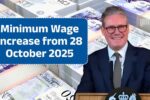Big news for UK pensioners! In 2025, a major proposal could allow retirees to earn up to £20,000 annually without paying any income tax. This would be a huge boost for pensioners looking to supplement their retirement income without worrying about paying taxes. In this blog post, we’ll break down everything you need to know about this new proposal, how it could impact your finances, and the best ways to make the most of this change.
What Is the £20,000 Tax-Free Income Proposal and Why It Matters?
The UK government is considering a new proposal that would allow pensioners to earn up to £20,000 annually without paying any income tax. This could be a game-changer for many retirees who are already facing financial challenges due to rising costs and reduced pension payouts.
Why does this matter? With the rising cost of living, many pensioners struggle to make ends meet on their state pensions alone. This proposal could give them a much-needed financial cushion, allowing them to keep more of their hard-earned money and live more comfortably in retirement.
When Will the £20,000 Tax-Free Income Start?
The £20,000 tax-free allowance is set to apply from the 2025-2026 tax year, meaning it could be in place as soon as April 2025. If the proposal moves forward, retirees would be able to earn up to £20,000 from employment, self-employment, or investments without paying any tax.
This is particularly important for pensioners who might still be working part-time or those who rely on rental income or dividends. They could earn an additional £20,000 each year, and keep every penny, without worrying about tax deductions.
How the £20,000 Tax-Free Income Works – Explained Simply
Under the current system, pensioners who earn above the standard tax-free allowance (£12,570) have to pay tax on their additional income. But with the new proposal, pensioners will be able to earn up to £20,000 without any tax liability.
For example, let’s say you’re a pensioner who works part-time or receives rental income. In 2025, if you earn £15,000 from your job and £5,000 from investments, you would be able to keep all £20,000, as it would fall within the tax-free limit. This would make a significant difference in your total income, especially for those relying on part-time work to stay financially stable.
This proposal aims to boost pensioner income without burdening them with extra tax responsibilities. Essentially, it means more disposable income for you to enjoy, whether you’re using it to travel, save, or simply cover everyday living expenses.
Common Mistakes With the £20,000 Tax-Free Income and How to Avoid Them
While this proposal sounds like a financial win for pensioners, there are a few common pitfalls to be aware of:
- Not Tracking Your Earnings: If you’re earning from multiple sources (like part-time work and investments), make sure to keep track of how much you’re making. The tax-free income is a cap, so if you exceed £20,000, you could be liable for taxes.
- Not Understanding the Rules for Different Types of Income: The £20,000 tax-free limit applies to all sources of income combined. This includes earnings from a job, self-employment, and even rental income or dividends. Keep an eye on all your income sources to ensure you don’t exceed the limit.
- Missing Out on Additional Tax Breaks: There might be other exemptions or tax reliefs available to pensioners that could help reduce your taxable income even further. It’s a good idea to consult a tax advisor to ensure you’re taking advantage of everything available to you.
Best Tips to Make the Most of the £20,000 Tax-Free Income Proposal
Now that you know how it works, here are some tips to maximize this tax-free income boost:
- Diversify Your Income Streams: If you’re not already earning from multiple sources, consider setting up a side hustle or investing in assets that generate passive income. This could include renting out a room, starting an online business, or investing in dividend-paying stocks.
- Keep Detailed Records: Track all your income carefully. You’ll want to ensure you stay under the £20,000 limit to avoid any unexpected tax bills. Use accounting apps or a simple spreadsheet to keep everything organized.
- Seek Financial Advice: If you’re unsure about how to navigate this new proposal, speak with a financial advisor. They can help you optimize your income strategy and ensure you don’t miss out on any tax-saving opportunities.
- Review Your Pension Plan: This proposal might also be a good time to review your retirement savings strategy. If you’re planning to supplement your income with part-time work or investments, you might want to adjust your savings plan to match your new financial goals.
The Latest Updates on the £20,000 Tax-Free Income Proposal
As of now, the proposal to allow pensioners to earn £20,000 tax-free is still in the discussion phase, and final approval is expected in 2025. However, the UK government has expressed strong support for the initiative, and many see it as a positive step to support the aging population.
Keep an eye out for official announcements and ensure you’re aware of any additional changes or requirements once the proposal is finalized.
Conclusion
If the UK government moves forward with this £20,000 tax-free income proposal in 2025, it could be a major financial boost for retirees. For many pensioners, this means more money in their pockets to help with everyday living expenses, travel, or simply improving their quality of life. While the proposal is still in the works, it’s a good idea to start planning ahead by reviewing your income streams and seeking expert advice.
By staying informed and being proactive, you can make the most of this exciting opportunity when it becomes law.
FAQ Section
When will pensioners be able to earn £20,000 tax-free?
The £20,000 tax-free allowance is expected to begin in April 2025 with the new tax year.
What types of income are covered by the £20,000 tax-free limit?
The £20,000 tax-free limit applies to all forms of income, including earnings from work, self-employment, rental income, and dividends.
Why is the UK government introducing this tax-free income for pensioners?
This proposal aims to support pensioners by increasing their disposable income without the burden of income taxes, especially given the rising cost of living.
How can I make the most of this £20,000 tax-free allowance?
To make the most of this opportunity, consider diversifying your income, tracking all your earnings carefully, and seeking advice on tax-saving strategies.
Can I earn more than £20,000 tax-free?
No, the £20,000 limit is a cap. If you earn more than that, the excess income will be taxed at the applicable rates.



